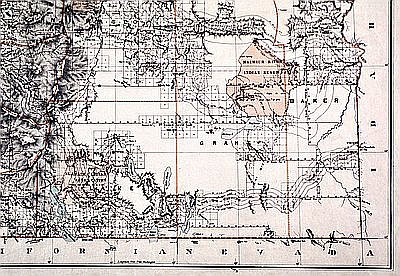The photograph above pictures the general merchandise store of Robbins & Purington in the ranching town of Drewsey, Harney County, as it looked about 1890.
Drewsey is located at the southern edge of the Blue Mountains on the Malheur River at the mouth of Stinkingwater Creek. The area was at the northern range of the Northern Paiute Indians. The 1860s gold discoveries near Canyon City and Austin were located within fifty miles of the future town, and miners actively prospected in the area. There were recurring conflicts between Indians and itinerant miners which culminated in an unratified treaty in 1868. The Malheur Indian Reservation was established in 1872, but was dissolved in the aftermath of the Bannock War of 1878 after pressures from white property-seekers. The growing cattle industry attracted ranchers, who moved into the area in the 1880s.
As for Drewsey, “[i]ts inception is coeval with the opening of the reservation, and to the influx of people resulting from the removal of the red man,” according to a bluntly-phrased account in An Illustrated History of Baker, Grant, Malheur and Harney Counties (1902). The first business in Drewsey was the general merchandise store opened by Abner Robbins and E. E. Purington (or Perrington) in 1883. Within a few years, the town had a hotel, three saloons, a post office, and a fraternal lodge. In 1900, with a population of perhaps 100, Drewsey was one of the four largest communities in Harney County, population 2,598. The county has an area of 10,228 square miles—twice the size of the state of Connecticut.
The Robbins & Purington store was constructed of rough-hewn local rock, probably held in place with adobe or clay. Milled lumber was used for the small addition with its false front, the roof, porch, and sidewalk. The lumber as well as the glass for doors and windows had to be brought to Drewsey by wagon. Similar vernacular stone buildings are found throughout southeastern Oregon, in communities such as Nyssa and Fields, and at isolated ranches such as the Whitehorse Ranch and Sod House.
Related Historical References:
National Register of Historic Places: Oregon—Harney County—Sod House Ranch (added 1979 - District - #79002061), south of Burns.
National Register of Historic Places: Oregon—Malheur County—Old Stone House (added 1972 - Building - #72001085); also known as Stone House Hotel, 283 S. Main St., Vale.
Written by Richard Engeman, © Oregon Historical Society, 2005.

